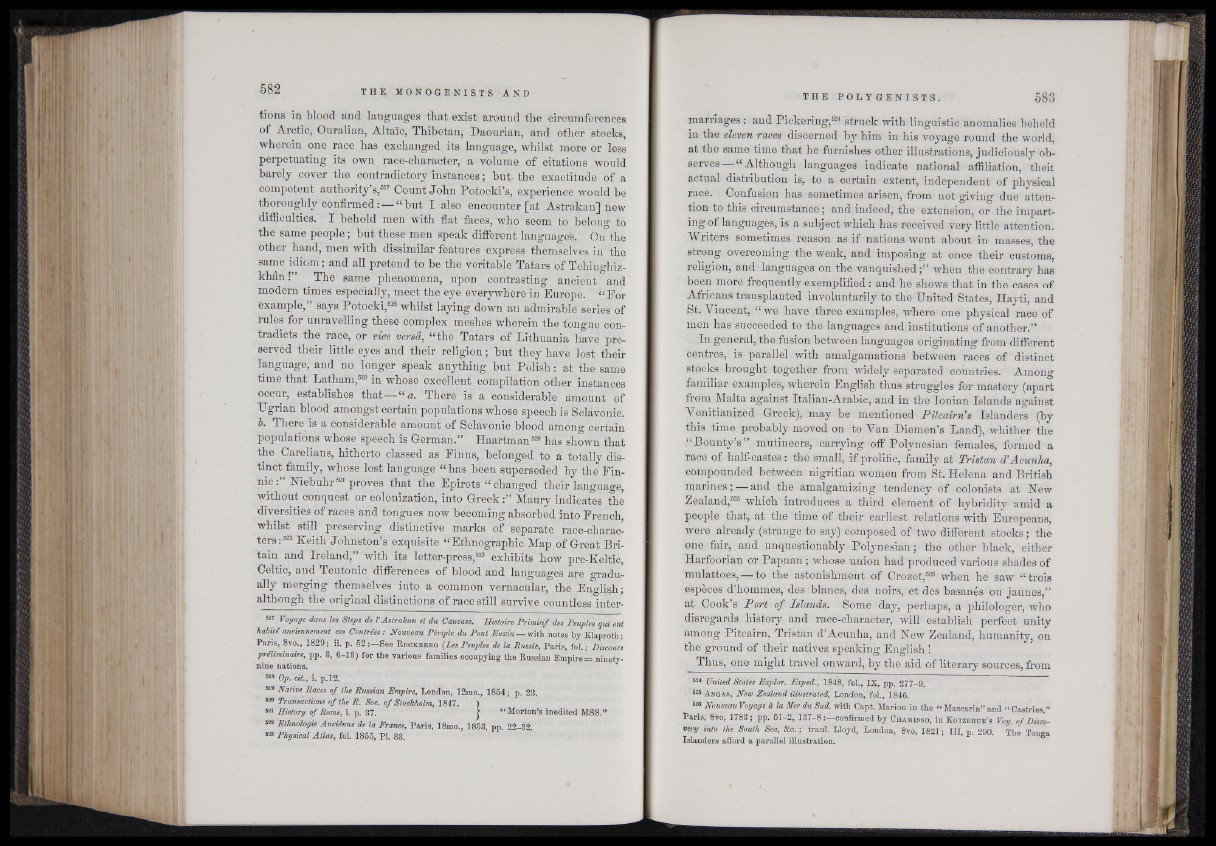
tions in blood and languages that exist around the circumferences
of Arctic, Ouralian, Altaic, Thibetan, Daourian, and other stocks,
wherein one race has exchanged its language, whilst more or less
perpetuating its own race-character, a volume of citations would
barely cover the contradictory instances ; buf. the exactitude of a
competent authority s,517 Count John Potocki’s, experience would be
thoroughly confirmed: —“ but I also encounter [at Astrakan] new
difficulties. I behold men with flat faces, who seem to belong to
the same people; but these men speak different language^. On the
other hand, men with dissimilar features express themselves in the
same idiom; and all pretend to be the veritable Tatars of Tchinghiz-
khàn !” The same phenomena, upon contrasting ancient and
modern times especially, meet the eye everywhere in Europe. “For
example,” says Potocki,618 whilst laying down an admirable series of
rules for unravelling these complex meshes wherein the tongue contradicts
the race, or vice versâ, “the Tatars of Lithuania have preserved
their little eyes and their religion ; but they have lost their
language, and no longer speak anything but Polish : at the same
time that Latham,619 in whose excellent compilation other instances
occur, establishes that—“ a. There is a considerable amount of
Ugrian blood amongst certain populations whose speech is Sclavonic.
b. There is a considerable amount of Sclavonic blood among certain
populations whosè speech is German.” Haartman520 has shown that
the Carelians, hitherto classed as Finns, belonged to a totally distinct
family, whose lost language “ has been superseded by the Finnic:”
Niebuhr621 proves that the Epirots “ changed their language,
without conquest or colonization, into Greek:” Maury indicates the
diversities of races and tongues now becoming absorbed into French
whilst still preserving distinctive marks of separate race-charac-
ters:622 Keith Johnston’s exquisite “Ethnographic Map of Great Britain
and Ireland,” with its letter-press,623 exhibits how pre-Keltic,
Celtic, and Teutonic differences of blood and languages are gradually
merging themselves into a common vernacular, the English;
although the original distinctions of race still survive countless inter517
Voyage dans les Steps de l’Astrakan et du Caucase. Histoire Primitif des Peuples qui ont
habité anciennement ces Contrées : Nouveau Périple du Pont Euxin — with notes by Klaproth ;
Paris, 8vo., 1829 ; ii. p. 52 :—See R eckberg (Les Peuples de la Russie, Paris, fol. ; Discours
préliminaire, pp. 3, 6-13) for the various families occupying the Russian Empire = ninety-
nine nations.
618 Op. cit., i. p. 12.
619 Native Races of the Russian Empire, London, 12mo., 1854; p. 23.
820 Transactions of the R. Soc. of Stockholm, 1847. )
821 History of Rome, i. p. 37. r “ Morton’s inedited MSS.”
822 Ethnologie Anciênne de la France, Paris, 18mo., 1853, pp. 22-32.
828 Physical Atlas, fol. 1855, Pl. 33.
marriages : and Pickering,624 struck with linguistic anomalies beheld
in the eleven races discerned by him in his voyage round the world,
at the same time that he furnishes other illustrations, judiciously observes
“ Although languages indicate national affiliation, theii
actual distribution is, to a certain extent, independent of physical
race. Confusion has sometimes arisen, from not giving due attention
to this circumstance ; and indeed, the extension, or the imparting
of languages, is a subject which has received very little attention.
Writers sometimes reason as if nations went about in masses, the
strong overcoming the weak, and imposing at once their customs,
religion, and languages on the vanquished;” when the contrary has
been more frequently exemplified : and he shows that in the cases of
Africans transplanted involuntarily to the United States, Hayti, and
St. Vincent, “ we have three examples, where one physical race of
men has succeeded to the languages and institutions of another.”
In general, the fusion between languages originating from different
centres, is parallel with amalgamations between races of distinct
stocks brought together from widely separated countries. Among
familiar examples, wherein English thus struggles for mastery (apart
from Malta against Italian-Arabie, and in the Ionian Islands against
Venitianized Greek), may be mentioned Pitcairn’s Islanders (by
this time probably moved on to Van Diemen’s Land), whither the
“Bounty’s ” mutineers, carrying off Polynesian females, formed a
race of half-castes : the small, if prolific, family at Tristan d’Acunha,
compounded between nigritian women from St. Helena and British
marines ; — and the amalgamizing tendency of colonists at New
Zealand,526 which introduces a third element of hybridity amid a
people that, at the time of their earliest relations with Europeans,
were already (strange to say) composed of two different stocks ; the
one fair, and unquestionably Polynesian; the other black, either
Harfoorian or Papuan ; whose union had produced various shades of
mulattoes, — to the astonishment of Crozet,628 when he saw “ trois
espèces d’hommes, des blancs, des noirs, et des basanés ou jaunes,”
at Cook’s Port of Islands. Some day, perhaps, a philologer, who
disregards history and race-character, will establish perfect unity
among Pitcairn, Tristan d’Acunha, and New Zealand, humanity, on
the ground of their natives speaking English !
Thus, one might travel onward, by the aid of literary sources, from
824 United States Explor. Exped., 1848, fol., IX, pp. 277-9.
825 A n g a s , New Zealand illustrated, London, fol., 1846.
828 NouveauVoyage à la Mer du Sud. with Capt. Marion in the “ Mascarin” and “ Castries,”
Paris, 8vo, 1783; pp. 51—2, 137—8:—confirmed by C h am is s o , in K o t z e b u e ’s Voy. of Discovery
into the South Sea, &c. ; tranl. Lloyd, London, 8vo, 1821 ; III, p. 290. The Tonga
Islanders afford a parallel illustration.